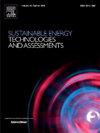超高水头抽水蓄能机组在水轮机失控过程中的不稳定流动机制
IF 7.1
2区 工程技术
Q1 ENERGY & FUELS
Sustainable Energy Technologies and Assessments
Pub Date : 2024-10-15
DOI:10.1016/j.seta.2024.104028
引用次数: 0
摘要
与传统水头机组相比,超高水头抽水蓄能机组(PSU)的上下游管道更长,内部流动更复杂。这种复杂性增加了模拟超高水头抽水蓄能机组(PT)瞬态流动的难度。在对超高扬程 PSU 的过渡过程进行数值研究时,确定准确的时变边界条件和分析复杂的压力脉动至关重要。本研究采用一维和三维(1D-3D)耦合计算方法模拟水轮机失控过程(TRP)。采用短时傅里叶变换(STFT)方法分析了瞬态压力的时频特征,揭示了各压力脉动成分的形成机理。除了传统头部 PT 在 TRP 期间出现的压力脉动成分外,还发现了一种新的压力脉动成分。该成分由低频向高频延伸,振幅较高,为旋转频率的 25 ∼ 27 倍,由瞬态流速脉动诱发。这可能会大大加剧轴向力的脉动。研究结果为后续超高扬程 PSU 的研发提供了参考。本文章由计算机程序翻译,如有差异,请以英文原文为准。
Instability flow mechanism of ultra-high head pumped-storage units during turbine runaway process
Ultra-high head pumped-storage units (PSUs) have longer upstream and downstream pipelines and more complex internal flows than those of conventional head units. This complexity increases the difficulty of simulating transient flows in ultra-high head pump-turbines (PTs). When numerically studying the transition process of an ultra-high head PSU, determining accurate time-varying boundary conditions and analyzing complex pressure pulsations is crucial. In this study, one- and three-dimensional (1D-3D) coupled computational approach was employed to simulate the turbine runaway process (TRP). The short-time Fourier transform (STFT) method was used to analyze the time–frequency characteristics of the transient pressure, revealing the formation mechanism of each pressure pulsation component. In addition to the pressure pulsation components that occur during the TRP in conventional head PTs, a novel pressure pulsation component was revealed. This component, extended from low frequency to high frequency and had a higher amplitude at 25 ∼ 27 times the rotational frequency, was induced by transient flowrate pulsations. This could significantly exacerbate the pulsation of the axial force. The findings provide a reference for the subsequent research and development of ultra-high head PSUs.
求助全文
通过发布文献求助,成功后即可免费获取论文全文。
去求助
来源期刊

Sustainable Energy Technologies and Assessments
Energy-Renewable Energy, Sustainability and the Environment
CiteScore
12.70
自引率
12.50%
发文量
1091
期刊介绍:
Encouraging a transition to a sustainable energy future is imperative for our world. Technologies that enable this shift in various sectors like transportation, heating, and power systems are of utmost importance. Sustainable Energy Technologies and Assessments welcomes papers focusing on a range of aspects and levels of technological advancements in energy generation and utilization. The aim is to reduce the negative environmental impact associated with energy production and consumption, spanning from laboratory experiments to real-world applications in the commercial sector.
 求助内容:
求助内容: 应助结果提醒方式:
应助结果提醒方式:


